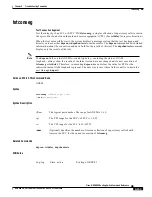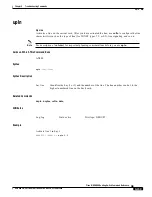
9-155
Cisco MGX 8850 Routing Switch Command Reference
Release 2.0, Part Number 78-10467-04 Rev C0, October 2001
Chapter 9
Troubleshooting Commands
tstdelay
tstdelay
Test Delay
Test the integrity of the connection in the ingress direction by sending a collection of supervisory cells
to the remote end of the network and back. (See tstconseg for the egress direction.) The tstdelay
command applies to only SPVCs.
If the test successfully begins, the display states the fact and directs you to use the dspcon or
dspchantests command to view the round trip time in microseconds. The dspcon display shows detailed
information on the connection and has a field for the test results. The dspchantests display shows the
results of only the round trip delay test.
Note
The dspcon fields on the AXSM for round trip delay—including the status of OAM
loopback—always show the results of the latest test and are not changed until a new execution of
tstconseg or tstdelay. Therefore, re-executing dspcon does not clear the value for RTD or the
indication that an OAM loopback is present. The only way to reset these fields to null is to down the
port (through dnport).
Note
The primary purpose of tstdelay is to test the integrity of the connection. The round trip time is not
accurate enough for any use that requires an accurate measurement of delay.
Cards on Which This Command Runs
AXSM
Syntax
tstdelay <ifNum> <
vpi
> <
vci
>
[-num <iterations>]
Syntax Description
Related Commands
dspcons, tstconseg, dspcon
ifNum
The logical port number. The range for AXSM is 1–60.
vpi
Virtual path identifier. On the AXSM, the range is 1–255.
vci
Virtual connection identifier. On the AXSM, the range is 32–65535 for a VCC. For a
VPC, the vci is 0.
-num
(Optional) Specifies the number of times a collection of supervisory cells should
traverse the SVC for the current execution of tstdelay.














































